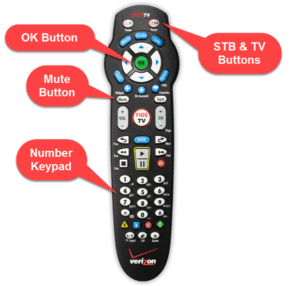FIOS Remote
 FIOS Remote: a reader asks…
FIOS Remote: a reader asks…
I have a simple question. The remote that came with my FIOS service has two buttons, one for TV and one for the STB (FIOS box). It came with a printed manual that I can’t make sense of. How can I get my FIOS remote to turn my TV on and off, and control the volume of the TV speakers? My TV is a Samsung 40″ flatscreen TV that’s about 4 years old, model LN40C630K1F. The remote manual says P265v1.1.
The paper manual has a list of TV brands and the code that you need to program the remote. For Samsung, that code is 331. While the paper manual that came with the TV is pretty straightforward, perhaps I can reformat the instructions to make it a bit easier for you to follow. Let’s break this into parts.
First, let’s program the TV button to control your Samsung flatscreen TV. To start, turn both the TV and the FIOS STB box on, so that you’re watching a television station.. Now, press these keys on the remote to find the correct remote setting for your TV:
 Press and hold the green OK button and the 0 (zero) keys at the same time. Hold them down till the red LED between the STB and TV buttons blinks twice and then stays lit.
Press and hold the green OK button and the 0 (zero) keys at the same time. Hold them down till the red LED between the STB and TV buttons blinks twice and then stays lit.- press the number keys (one after the other) 3, 3, and 1. The red LED will blink twice and continue to stay on.
- Press the channel up button and repeat pressing that until the TV turns off. Don’t repeat the presses too fast or you might go past the setting. When you press the channel up button, it cycles through the variation settings for the Samsung TV line, so you want to stop pressing the button as soon as the TV turns off, which leaves the remote on the setting for your particular TV.
Now you want to test that the setting works right for you, and then lock in the setting:
- To test, press the TV button – the TV should turn back on. Press the volume up and down buttons to make sure that the TV volume goes up and down. Press the Mute button and make sure the sound is muted, press it again to restore sound.
- If any of those keys don’t do what they’re expected to do, press and hold that key, and release it as soon as it starts working.
- Once you know that all keys are working correctly, press the green OK button to lock in the setting on the remote. The red LED will blink three times and then turn off.
As a bonus, you can set the remote so you only have to press the STB button to turn on both FIOS box and TV. To do this, first turn on both TV and FIOS box. Then press these buttons on the remote:
- Press and hold the green OK button and the 2 (number 2 on the numeric keypad) for a second or two, then release the buttons. The red LED should blink twice and then stay lit.
- press the number keys (one after the other) 9, 7, and 7. The red LED will blink twice and stay lit.
- Press the STB button, the red LED will blink three times and then turn off.
 Now when you press the STB button, both TV and FIOS box will turn on. Press the STB button again to turn them both off. Occasionally, you may find that the TV is on while the STB box is off, or vice versa, and the remote just switches them around. That’s because for some reason one or the other component didn’t get the on/off signal from the remote last time it was used. To fix this, just use the buttons on the TV and FIOS box to make sure both are either on, or both are off. Then the FIOS remote button will turn them both on.
Now when you press the STB button, both TV and FIOS box will turn on. Press the STB button again to turn them both off. Occasionally, you may find that the TV is on while the STB box is off, or vice versa, and the remote just switches them around. That’s because for some reason one or the other component didn’t get the on/off signal from the remote last time it was used. To fix this, just use the buttons on the TV and FIOS box to make sure both are either on, or both are off. Then the FIOS remote button will turn them both on.
This kind of a problem often happens because when you press the buttons, you may not be pointing the remote in the direction of the TV and FIOS remote box. The remote actually sends two signals, one to the FIOS box and one to the TV. If you press the button and immediately put the remote down, the second signal may not have been received by the device (TV or FIOS box), resulting in one being on and one being off.
Hint: keep the remote pointed at the TV for a second or so after you press the button and you’ll avoid this problem.
This website runs on a patronage model. If you find my answers of value, please consider supporting me by sending any dollar amount via:
or by mailing a check/cash to PosiTek.net LLC 1934 Old Gallows Road, Suite 350, Tysons Corner VA 22182. I am not a non-profit, but your support helps me to continue delivering advice and consumer technology support to the public. Thanks!
 Press and hold the green OK button and the 0 (zero) keys at the same time. Hold them down till the red LED between the STB and TV buttons blinks twice and then stays lit.
Press and hold the green OK button and the 0 (zero) keys at the same time. Hold them down till the red LED between the STB and TV buttons blinks twice and then stays lit.






Is there a way to have the Verizon remote turn off ONLY the TV? We don’t want the STB to turn off as it then has to go thru its reinitializing every time it’s turned back on. Thanks
Hi Jessica, thanks for your question. The FIOS remote should only put the STB in standby mode when you hit the power button. My guess is that the STB is malfunctioning if it is rebooting every time you press the remote power button.
You may want to contact Verizon to have them replace it. Verizon STBs do have a service life and can start malfunctioning anywhere from 1-10 years (just like most other consumer electronics devices).
In case you need it, the remote manuals for FIOS are all online, you can click on the one you have at https://www.verizon.com/support/residential/tv/equipment/remote-control to see a programming guide for it.